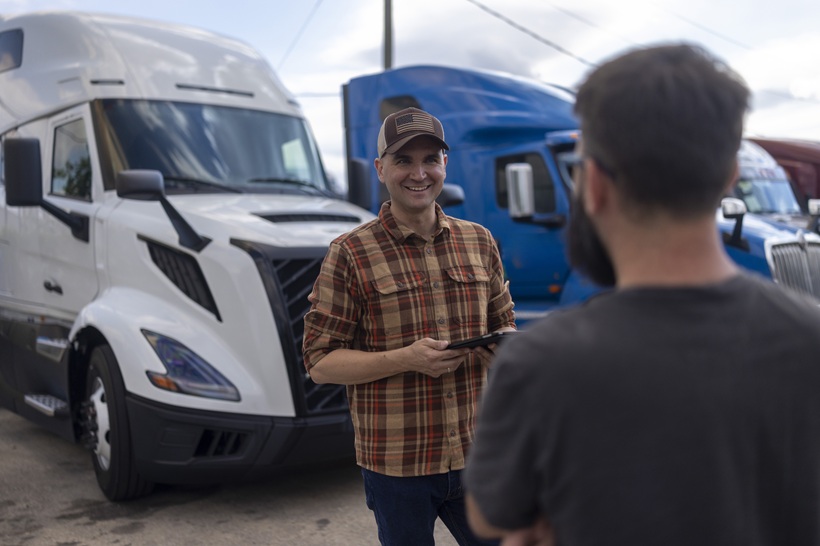
5 Predictions for the Trucking Industry in 2025
The 2020s have been a whirlwind of upheaval and transformation for industries worldwide, but few sectors have experienced as much of a rollercoaster as trucking. Over the past half-decade, the freight industry has faced huge challenges: navigating COVID-19 lockdowns, a historic boom in 2021 and 2022 with significant capacity expansions, and the prolonged freight recession of the last two-plus years.
Fortunately, market indicators now signal an end to the two-year freight recession, setting an optimistic tone for 2025. However, hauling and brokering freight are complex endeavors, with nuances that can shift on a whim. To explore these dynamics and gather insights into the road ahead, Transflo hosted two webinars in late 2024, one focused on carriers and the other on brokers.
For the carrier session, Misty Darnell, Senior VP of Corporate Development and Accounting at Paschall Truck Lines and Praveen Boppana, Chief Information Officer at Bennett Family of Companies, joined Danny Goldstein, VP of Solution Engineering at Transflo. When we held our brokerage-focused event, John Gillespie, Chief Technology Officer at MegaCorp, and Matt Ziegler, President at ZMac Transportation Solutions, met up with Don Everhart, Head of Partnerships and Strategy at Transflo.
Drawing from their expertise, we present five trucking industry predictions for the coming year.
1. The market will improve, but don’t expect a post-COVID boom.
As 2024 comes to a close, industry consensus points to a recovery in the freight market. While this is welcome news, expectations of a post-COVID-style boom are unrealistic.
Panelists in the carrier webinar offered nuanced views. Darnell forecasted a largely flat market in the first half of 2025, with signs of an uptick in the latter half of the year. Boppana expressed a bit more optimism about seeing positive trends as early as Q1 or Q2 of 2025, citing favorable indicators emerging in Q4 of 2024. He emphasized that comparisons to the 2021-22 boom — an outlier driven by supply chain backlogs — would be misleading. “Every time we look at 2024, we compare it to 2022,” Boppana noted, “which is an outlier.”
Adding to the uncertainty is a potential January strike by the International Longshoremen’s Union, which could affect East and Gulf Coast ports. While the market’s trajectory is positive, challenges remain, and freight rates may not see prolonged elevation in the near term.
2. AI usage in trucking will improve and become more refined.
AI continues to make its presence felt across industries, and trucking is no exception. However, the adoption and application of AI vary between carriers and brokers, with both groups recognizing its potential but facing unique challenges.
During the broker webinar, Ziegler voiced skepticism about AI’s ability to accommodate idiosyncratic brokerage needs in its current form, though he acknowledged its growing influence and shared success with AI lead development tools at ZMac. Gillespie emphasized the necessity of integrating AI tools with the specific needs of shippers and carriers and stressed that the human element remains indispensable in brokerage operations.
Carriers, on the other hand, struck a more optimistic tone. Darnell and Boppana highlighted opportunities for AI to streamline back-office tasks, enhance driver safety, and solve operational challenges more efficiently. Both groups agreed that while current AI applications may have limitations, rapid improvements and expanded use cases are on the horizon.
3. Amid the fraud epidemic, strong broker-carrier relationships will become even more imperative.
Freight fraud accelerated in 2024, with some even wondering if it represented the “perfect crime.” While carriers can employ tracking technology to protect their specific assets from theft, fraud on either side of a broker-carrier arrangement with an untrustworthy company is still rampant.
For brokers, the key lies in fostering authentic partnerships with carriers that go beyond transactional agreements. Tools for vetting carriers are more advanced than ever, yet gaps still exist — particularly in vetting from the other side, where brokers themselves are scrutinized. Building relationships with carriers who value transparency, timely payments, and fair practices can reduce vulnerability to fraud while boosting operational efficiency.
From the carrier’s perspective, working with trusted brokers ensures fewer risks, such as delayed payments or mishandled loads. This trust is built on communication and collaboration, aided by technology. For instance, better APIs and integrated systems not only streamline operations but also provide verifiable data, enhancing mutual accountability.
Technology alone, however, isn’t the silver bullet. Carriers and brokers need to champion education and proactive fraud prevention strategies. Brokers should prioritize explaining “the why” behind new technologies and policies to their carrier partners, fostering buy-in and shared accountability. Certification programs for trusted carriers or brokers could also emerge as industry-led initiatives to weed out bad actors.
4. Federal regulatory rollback will help carriers to an extent, but state regs will remain a concern.
Regulations are a perennial challenge for trucking, and the shifting political landscape promises to bring changes at the federal level. With a new presidential administration taking office in January, expectations are high for a rollback of controversial federal regulations that impact trucking.
During the carrier webinar, Misty Darnell noted that while 2024 regulations had minimal immediate impact on Paschall Truck Lines, forthcoming EPA emissions rules slated for 2027 could significantly raise asset costs. These rules, which essentially mandate electric truck adoption, might face delays or reversal under the new administration.
Yet, state regulations are likely to persist as a source of complexity. The California Air Resources Board (CARB) has consistently set stricter emissions standards than the EPA, which are often adopted by other states. If the federal government revokes California’s EPA waiver that allows the state to adopt stronger rules, it could spark legal battles with significant implications for carriers.
5. Autonomous trucking will enter a new era in 2025.
Electric and autonomous trucks are clearly two major technologies on the horizon that will impact the industry significantly in the coming years. But as we alluded to in the previous section, EVs aren’t exactly the industry’s friend at the moment.
This isn’t because carriers want to use diesel forever. It’s because the current equipment costs are significantly higher than a traditionally powered Class 8 truck, the current charging infrastructure is incompatible with the needs of fleets, and because of potential mandates.
That’s not the case for autonomous trucks, which the carrier panelists pointed out as something that they’ll be monitoring as the technology continues to develop. As of the summer, several companies’ autonomous truck technology was being tested, and that’s continued as the year has progressed. Some have even speculated that autonomous trucking and routes could become an altogether new class of freight.
New year, new opportunities
The trucking industry in 2025 stands at the crossroads of innovation, recovery, and adaptation. From AI advancements to evolving regulatory landscapes and autonomous trucking, the road ahead promises both challenges and potential. Building trust, embracing technology, and fostering resilient partnerships will be key to navigating these changes. By staying agile and informed, carriers and brokers alike can position themselves for success in an industry that continues to move the nation forward.
TL;DR
Based on expert webinars, here are five 2025 trucking predictions: (1) Market recovery without boom—freight will improve but won’t match the 2021-2022 surge, (2) AI refinement—brokers remain skeptical about current capabilities while carriers see promise for back-office tasks and safety applications, (3) Trust becomes critical—accelerating fraud makes authentic broker-carrier partnerships with transparency and fair practices essential for survival, (4) Mixed regulatory environment—federal rollbacks under the new administration may help with EPA emissions rules, but state regulations (especially California CARB) will persist, and (5) Autonomous trucking advances—unlike costly electric trucks, autonomous technology is actively being tested and could create entirely new freight classes.



